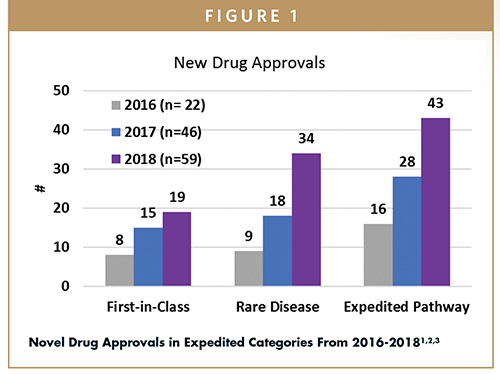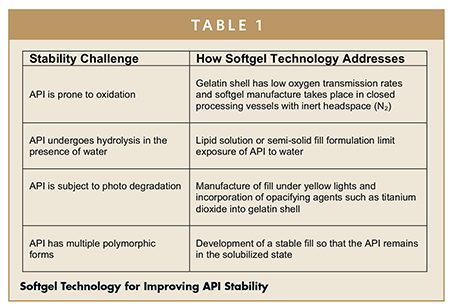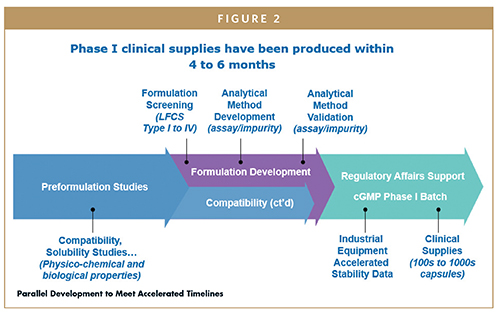Issue:May 2019
DRUG DEVELOPMENT - Softgel Technology for Fast-Tracked Development Programs
INTRODUCTION
Throughout the past few years, the pharmaceutical industry has undergone a significant change in terms of companies’ R&D strategic areas of focus and the resulting new drug products that they intend to bring to market. In the past, R&D efforts were primarily aimed at the development of products for the treatment of widespread disease states consisting of large patient populations in hopes of “blockbuster” products with large and lucrative sales. While pharmaceutical companies still devote significant resources to these larger target therapeutic areas, in recent years, there have been considerable developmental efforts to bring new drug products to market for the treatment of rare or orphan diseases. In many cases, these new products represent “first-in-class” therapies. As such, there is often a high level of public interest in getting these new, potentially life-saving drug products approved and to patients as quickly as possible. This is illustrated in Figure 1, which highlights the total number of new drug approvals (NDAs) by the FDA, and how many each year represent “First-in-Class” therapies, “rare disease” indications, and receiving “Expedited Pathway” review between 2016 and 2018. The number of drug products that were designated in one or more of the four FDA expedited categories of Fast Track, Breakthrough, Priority Review, and Accelerated Approval has steadily increased in number in that time.

According to the FDA’s most recent data, 43 of the 59 novel drug approvals in 2018 (73%) were designated in one or more of these four expedited categories.4 While standard times for new product approval have greatly improved throughout the past few years as a result of the Prescription Drug User Fee Act (PDUFA), the FDA review process for new products designated for expedited review can be 6 to 10 months shorter.
Given the trend toward more expedited-review designated products, project development teams are being challenged to complete their Chemistry, Manufacturing, and Controls (CMC) development work necessary for NDA submission in much shorter timeframes, often 18-24 months earlier than typical development timelines. Failure to meet these aggressive timelines not only carries serious business implications for companies, but more importantly, means that patients will not receive medicines they critically need as soon as possible.
Whereas in the past, regulatory filing dates were often predicated on the completion of clinical studies, for those drugs being given expedited review, there is a greater likelihood that the timely completion of CMC development activities will be on the critical path of timelines for the submission of NDAs. These shorter development cycle times leave little room for error. Having to repeat development work because, for example, a suboptimal formulation approach was initially pursued and resulted in poor bioavailability or unacceptable stability, can result in significant delays for new product programs. Forging ahead with a suboptimal formulation approach may jeopardize the success of the program at later stages of development, or ultimately, the agency’s approval of the drug as a result of CMC and/or quality issues. For these expedited programs, getting it right the first time is paramount. Having to switch formulation technologies midstream in a development program can mean additional time and costs for the project, and often requires bridging (clinical and/or stability) studies. From the formulator’s perspective, being able to zero-in on a suitable formulation approach based on the API’s chemical properties, such as solubility, permeability, pharmacokinetics, and stability, and the API’s solid state properties, including its crystallinity, polymorphism, and salt form during the early phases of development, is preferable to trying to identify the best approach after the drug has already undergone several years of development. This is best achieved as a collaborative effort between the medicinal chemist and the formulator. Ideally, the same formulation approach selected for the early phases of development can also be used in later development, and ultimately, for the commercial manufacturing of the product. By doing so, it is more likely the NDA submission dates called for in tight project timelines for expedited programs can be met.
SOFTGEL TECHNOLOGY FOR FAST-TRACKED DEVELOPMENT PROGRAMS
Given the accelerated timelines associated with these expedited programs, lipid-based drug formulations, encapsulated in softgel capsules, provide an attractive option for addressing the challenges facing formulators. Importantly, this technology offers formulators the advantage of an approach that addresses challenges faced during early development, such as improving drug absorption as well as those challenges encountered in later development including the ease of scalability. Lipid-based formulation allows for the timely completion of early and late-phase development activities, and provides relatively straightforward scale-up dosage form manufacturing to meet the commercial volume demand requirements for newly launched products. In doing so, the risk of having to switch to another formulation approach during development, and ensuing costly time delays, can largely be avoided.
Early-Stage Development
The majority of new drugs slated for expedited review are classified as Biopharmaceutical Classification System (BCS) II and Developability Classification System (DCS) IIa/IIb compounds, mirroring the types of compounds in today’s pharmaceutical pipeline.5,6 Many of these challenging compounds will likely require an enabling technology to overcome poor bioavailability resulting from their limited aqueous solubility. The benefits of utilizing lipid-based formulations to improve bioavailability of poorly water-soluble compounds have been well documented, and lipid-based formulations as solutions are often better absorbed compared to other solid oral dose form approaches.7 In particular, the development of lipid-based solutions for hydrophobic drugs, which can undergo digestion in vivo, and/or self-emulsify to very fine dispersions (self-(micro)emulsifying drug delivery systems; SEDDS or SMEDDS) upon contact with aqueous gastrointestinal contents, can provide significantly improved solubility. The result can be improved absorption (exposure) as well as reduced absorption variability caused by intra- and inter-patient variability or food effects.
GLP toxicology formulations of BCS II (DCS IIa/IIb) compounds often utilize traditional aqueous-based suspension or “powder-in-a-bottle” approaches for early animal safety studies. As a consequence, target exposure levels are not achieved during dose escalation studies and a threshold dose in which adverse effects are observed is unattainable.8 The utilization of lipid-based formulations of the drug to achieve adequate exposure allows for the successful and timely execution of these early safety studies, as well as being an approach that can be maintained throughout early bioavailability/pharmacokinetic studies and first-in-human studies, thereby obviating the need for the development of multiple formulations.
The lipid-based formulations and softgel technology address numerous other challenges that can arise during early development and can potentially delay project timelines. Ensuring dose uniformity can be problematic for highly potent, low-dose drugs. For example, the process challenges faced in trying to achieve acceptable content uniformity of a very low-dose drug – micrograms or milligrams per dosage unit – during the mixing of a powder bed, especially during scale up to larger batch sizes, can be difficult and potentially extend process development timelines. While uniformity of dose typically manifests itself during the scale-up of manufacturing processes for a new product, variable dosing in early development can be equally troublesome and can result in questionable data. To overcome these dose uniformity issues, it is best that they are dealt with as early as possible in development. Ensuring API uniformity in the formulation via the development of fill solutions represents a more effective means than the reliance on processing equipment. Furthermore, once the fill solution is manufactured, it is encapsulated on an encapsulation machine using a highly accurate positive displacement pump allowing for a uniformity of dosage of +/- 1% to be achieved. Another challenge frequently encountered and relating to highly potent or toxic new drug compounds is their safe handling. As with uniformity issues, safety typically becomes a major consideration for larger scale manufacture. However, even during the manufacture of lab-scale batches in early development, the potential for dust generation and exposure to personnel is reduced given that the drug is wetted during the fill formulation preparation. This provides an added degree of comfort and often means less aggressive measures need to be taken for employee protection, such as full personal protective equipment and engineering controls for isolation and containment.
In addition to the aforementioned issues, there are other API challenges that are best addressed during early development to avoid significant delays later in the product’s development. Despite showing promising activity, unfortunately, many new drugs are unstable and can often be prone to oxidation, hydrolysis or light degradation. As shown in Table 1, the softgel technology can be used to improve the stability of these drugs.

To meet the aggressive timelines for expedited programs, many pharma companies, contract research organizations (CROs), and contract development and manufacturing organizations (CDMOs), including Catalent, have looked for ways to reduce formulation development times required for producing Phase I clinical supplies. For expedited softgel programs, it is now possible to provide clinical supplies within 4 to 6 months, as shown in Figure 2.

The standard time for the development of softgel prototype fill formulations for screening in animal pharmacokinetic (PK) studies is 6 to 8 weeks. Shortened times for fill formulation development are possible through the utilization of robotic systems and generic high-performance liquid chromatography (HPLC) methods, which allow for the rapid screening of drug solubility in selected excipients. Similar approaches have been employed to generate drug-excipient compatibility data. These studies are performed with a few grams of API, which in the early phases of development, is often only available in very limited quantities.
Pharmacokinetic analysis and modeling using in silico software, such as GastroPlusTM during the early phases of development, have also proven to be valuable tools, often identifying true bioavailability issues, whether that be poor solubility, poor dissolution, or high first-pass metabolism, and assessing the importance of parameters, such as drug particle size. These insights can aid formulators in making sound scientific judgements regarding their formulation efforts.
Based on initial animal PK data and in vitro development studies, one or more viable candidate fill formulations can quickly be selected for further testing. These studies are typically performed in higher species of animals, such as dogs or monkeys, or directly into humans. It is at this phase of development that fill formulations are typically encapsulated to facilitate unit dosing of the drug. This includes the selection of a shell, which is compatible with the fill formulation, and given that the shell has negligible impact on the fill properties, such as dispersion and digestion of lipid-based fills, similar in vivo performance data as well as stability to that observed in early studies, would be anticipated throughout the development of the product.
Late-Stage Development
Avoiding time delays can also be achieved with the softgel technology during the later stages of development, thereby enabling tight timelines to be met. While other technologies can often require major changes to formulation and processing steps to deal with challenges that arise during scale-up, this is not normally the case with softgels. The fill formulation and shell selected during early development will essentially remain the same throughout scale-up and commercial manufacture, and the same can be said for the process. The same equipment train and process, including the mixing equipment for the preparation of the fill and shell (gel mass) as well the encapsulation machines for manufacture of the softgels, are also used when scaling-up to production-scale batch sizes. The time needed for scale-up activities can be considerably less for the softgel technology compared to processes required, and challenges, such as uniformity and safety, faced for other dosage form technologies.
The fact that softgel fill formulations and their encapsulation normally do not normally undergo significant changes during the later stages of development is important for several reasons when dealing with accelerated timelines. This allows for the upfront identification of critical formulation and process parameters, and the establishment of rationale ranges, during early development. It can be easily adapted to meet initial commercial volumes for a new product and scaled-up to larger batch sizes to cover increased demand as label indications expand. These same parameters and ranges tend to apply as batch sizes increase to larger scale. It also minimizes the risk of unwanted stability changes that can occur due to major changes to formulation or process late in the development of a product as is often the case with other technologies. Stability data generated on the softgel fill and shell during the early phases of a development program are usually applicable to stability data obtained for larger scale and registration batches manufactured in the later phases of development. As such, early phase stability studies often offer excellent longer-term supporting stability data for establishing a new product’s shelf-life.
SUMMARY
There are many factors and challenges that can potentially extend development timelines. In the early phases of development, many of these often relate to properties of the new drug compound. Lipid-based formulations encapsulated using softgel technology offer an attractive option for reducing development times in the early and later phases of fast-tracked or expedited product development programs. Benefits include improved bioavailability of poorly water-soluble drugs, improved stability, better content uniformity for potent or low dose drugs, and the safer handling of potent or toxic compounds. Delays can be avoided against accelerated product development timelines because softgel formulations and manufacturing processes established early in development can also be used without major modifications in the commercial manufacture of the product. Finally, the scale-up and manufacture of new drug products to meet commercial demand using the softgel technology is relatively straightforward and will not affect quality or performance of the product.
REFERENCES
- https://www.fda.gov/downloads/AboutFDA/CentersOffices/OfficeofMedicalProductsandTobacco/CDER/ReportsBudgets/UCM591976.pdf.
- https://www.fda.gov/downloads/Drugs/DevelopmentApprovalProcess/DrugInnovation/UCM629290.pdf.
- https://www.fda.gov/downloads/Drugs/DevelopmentApprovalProcess/DrugInnovation/UCM536693.pdf.
- FDA Center for Drug Evaluation & Research, “Advancing Healthcare Through Innovation-2018 New Drug Therapies”, Jan 2109, www.fda.gov.
- Butler JM, Dressman JB. The developability classification system: application of biopharmaceutics concepts to formulation development. J Pharm Sci. 2010;99: 4940-4954.
- Bayliss et al., 2016. Quality guidelines for oral drug candidates: dose, solubility and lipophilicity. Drug Disc Today, 21(10), 1719-1727.
- Ronak Savla, Jeff Browne, Vincent Plassat, Kishor M. Wasan & Ellen K. Wasan (2017) Review and analysis of FDA approved drugs using lipid-based formulations, Drug Development and Industrial Pharmacy, 43:11, 1743-1758, DOI:10.1080/03639045.2017.1342654.
- Pointeaux T et al. Fast-tracking time to market in the early stages of drug development. Drug Development & Delivery. 2011;11(8):60-66.
To view this issue and all back issues online, please visit www.drug-dev.com.

Dr. Jeff Browne has 40 years of experience in the pharmaceutical industry and held various positions in drug delivery R&D and pharmaceutical manufacturing. Since he joined Catalent Pharma Solutions (formerly RP Scherer) in 1994, he has worked in the softgel technology area and held a variety of positions including his most recent role as Director of Science & Technology. Dr. Browne earned his bachelor’s degree in Pharmacy and his doctorate in Industrial and Physical Pharmacy from Purdue University in West Lafayette, Indiana.

Dr. Ronak Savla is the Scientific Affairs Manager at Catalent Pharma Solutions and a Co-Chair of the Catalent Applied Drug Delivery Institute. Dr. Savla is responsible for the strategy and execution of the scientific communications plan, management of external collaborations, identification and nurturing relationship with key opinion leaders, and scientific assessment of novel drug delivery technologies. Dr. Savla is an author on more than 60 papers, articles, posters, and abstracts and has given dozens of conference presentations that cover a wide range of drug delivery topics.
Total Page Views: 5777










